Many people believe a data scientist is like a wizard. They think these experts can use AI to fix any issue. But that’s not true. Getting information from the database isn’t their top priority right now. A data scientist analyzes large data sets. They use different tools and techniques to find insights. This helps in making informed decisions. A data scientist has key responsibilities. They collect, organize, and analyze data.
To begin with, a data scientist needs to understand the business problem that needs to be solved. They then determine what data is needed to solve the problem and where to obtain it. Once they have the data, they will then use various methods to clean and pre-process it, ensuring that the data is accurate, complete, and ready for analysis.
What Does a “Data Scientist” Actually Do?
Now that that’s out of the way let’s imagine a day in the life of a data scientist who works for an audiobook company.
What does a data scientist do? Let’s look at how this works in the real world


Audioguide owns and runs a platform that helps people get audiobooks. People who don’t pay can watch up to 30 minutes of content for free every day because of how they run their businesses.
Ben, in charge of digital marketing at Audioguide, talks to Rita, a data scientist, and asks her to make a machine learning model to help more free users become paid subscribers.
How to make a Data Strategy out of Business Goals?
Ben used numbers to compare how well the company did to how well its rivals did. The company isn’t doing as well as its competitors, as shown by these numbers. Audioguide needs to get its free-to-paid conversion rate up to 20%, which is the average for the industry. Right now, that rate is only 5%.
Trying to Find Answers That Are Easier to Understand
Rita saw that other companies were offering discounts on their products for a limited time. She decided to try this first because she thought it was the most accessible and likely to work.
She thought that if Audioguide gave free users a 50% discount on the product during the first five days after signing up, the company’s free-to-paid conversion rate might go from 5% to 20%, which would double the business’s monthly revenue. She told the group working on the project to do an A/B test.
A/B Evaluation
As Rita worked on the A/B test, she had to think about the sample size, the test’s length, and the test’s power. The data showed that a campaign that had to be done quickly had a significant effect that could be measured statistically.
Analysing Exploratory Data (EDA)


Rita then did an exploratory data analysis (EDA) to learn more about how customers act and what factors might lead to the discovery of more value.
She found something exciting when she looked in her study. Users on the free plan who used the product and listened to it for at least an hour and a half in the first three days of their trial were four times more likely to switch to a paid plan.
Rita told Ben and Patrick, who are in charge of products at Audioguide and work there, what she had found. They decided to try a test in which free users could access all premium content and one-of-a-kind features for 24 hours after joining.
Because the A/B test went well, Audioguide made the suggested changes and sent them to all free users. After a few months, Ben told Rita that 15% of the company’s free users had paid to become premium customers. They were getting closer to the average for their industry, which was 20%.
Overlap in Roles
Rita made a REST application programming interface so that the app could make predictions quickly and in real-time. In this way, the user wouldn’t notice any difference.
Rita finally did an A/B test to see if the model’s results were accurate in the real world. After a few months, the financial data showed a significant change. Rita and all the hard work she did deserve most of the credit. After that, everyone lived the rest of their lives in perfect peace.
In addition to these core responsibilities, data scientists must also stay up-to-date with the latest developments in the field and constantly refine their skills to remain effective. This may involve attending conferences, participating in online communities, and reading academic papers.
Data scientists help businesses and organizations make better decisions. They use their skills in data analysis to provide valuable insights. This requires a combination of technical skills, business acumen, and communication abilities.
The above case study is a perfect example of the need for data science training. The data science course helps individuals tackle all kinds of situations in a firm. The data science institute is the best place to take up the data science certification program.





